
The Gnaphalieae are a tribe of flowering plants in the family Asteraceae. It is most closely related to the tribes Anthemideae, Astereae, and Calenduleae.

Rhodanthe, also known as sunray or pink paper daisy, is a genus of Australian plants in the tribe Gnaphalieae within the family Asteraceae.
Helipterum is a genus of flowering plants in the sunflower family.

Mirbelia is a plant genus belonging to the family Fabaceae. It is endemic to Australia, occurring in every mainland state except South Australia.

Thomasia is a genus of thirty-one species of flowering plants in the family Malvaceae. Plants in this genus are small shrubs that are endemic to the south-west of Western Australia, apart from P. petalocalyx that is native to Victoria and South Australia. The leaves are simple with leaf-like stipules at the base of the petiole, the flowers bisexual with five papery, petal-like sepals, usually five petals and five stamens opposite the petals. The fruit is a capsule covered with star-like hairs.
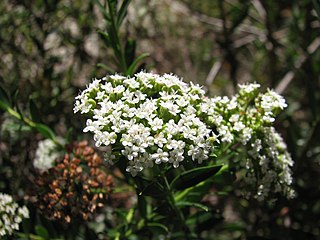
Platysace is a genus of woody perennial herbs and subshrubs in the family Apiaceae. The genus is endemic to Australia.

Guichenotia is a genus of about 16 species of flowering plants that are endemic to the south west of Western Australia.
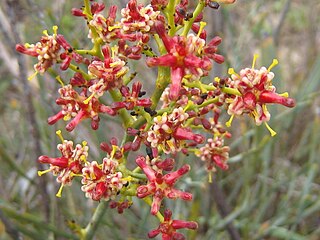
Stirlingia latifolia, commonly known as blueboy, is a plant endemic to Western Australia.

Orthrosanthus is a genus of flowering plants in the family Iridaceae first described as a genus in 1827. It native to Australia, Mexico, Central and South America.

Scholtzia is a genus of flowering plants in the family Myrtaceae, which are endemic to the south-west of Western Australia. The genus was first described by Schauer in 1843, who named it in honour of the physician Heinrich Scholtz. The type species is Scholtzia obovata.
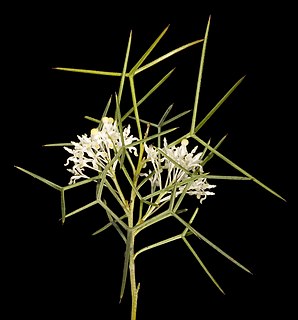
Grevillea paniculata is a shrub which is endemic to the south-west of Western Australia. It grows to between 0.6 and 3 metres in height and produces white, cream or yellow flowers between June and November in its native range.
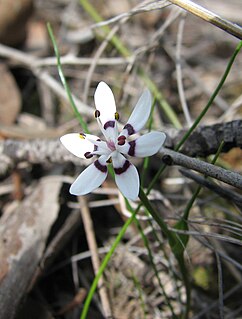
Wurmbea is a genus of perennial herbs in the family Colchicaceae, native to Africa and Australia. There are about 50 species, with about half endemic to each continent.

Velleia is a genus of herbs in the family Goodeniaceae. Of the 22 species, 21 are endemic to Australia, and one is endemic to New Guinea. The genus was named by James Edward Smith, after Thomas Velley.
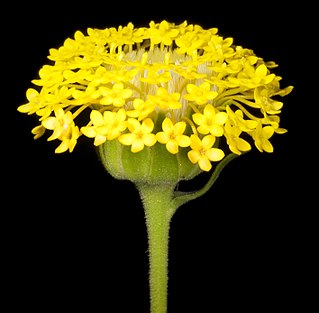
Podotheca is a genus of flowering plants in the tribe Gnaphalieae within the family Asteraceae. All species are endemic to Western Australia, except for Podotheca angustifolia which occurs across the south of Australia.
Leptorhynchos is a genus of annual or perennial herbs in the family Asteraceae. All species are endemic to Australia. These include:
Stemona australiana is a plant species native to tropical south-east Asia, including northern Australia and Papua New Guinea. It grows as a herb or climber up to two metres high.
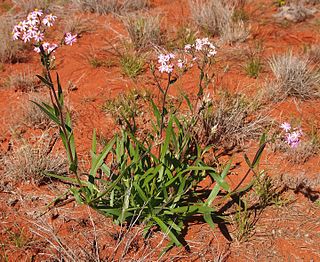
Schoenia is a genus of Australian plants in the tribe Gnaphalieae within the family Asteraceae.

Waitzia acuminata, commonly known as orange immortelle, is an annual herb in the family Asteraceae. It is native to Australia. Plants grow to between 0.1 and 0.6 metres in height and have leaves that are long and narrow. These are between 2 and 10 cm long and 2 to 5 mm in width. The yellow, orange or white flowers appear between July and January.
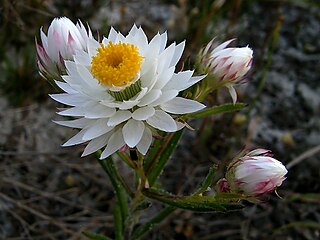
Waitzia suaveolens, commonly known as fragrant waitzia, is an annual herb in the family Asteraceae. It is endemic to the south-west of Western Australia. Plants grows to 0.6 metres in height and flower between September and January.

Pterochaeta is a monotypic plant genus in the Asteraceae family, endemic to Western Australia. It was first described in 1845 by Joachim Steetz and its only species is Pterochaeta paniculata.

















